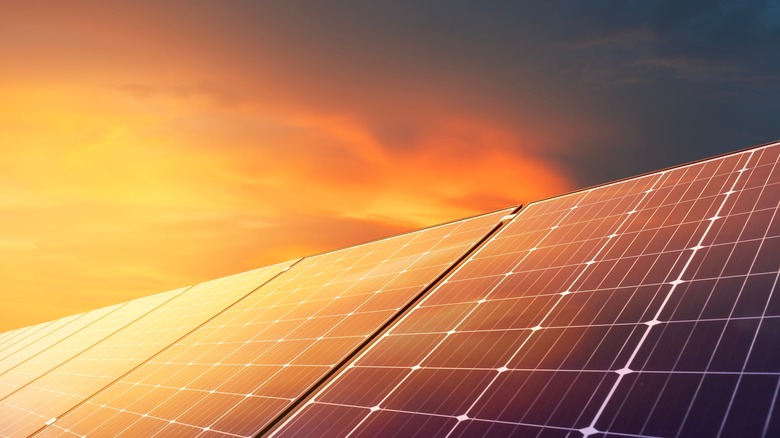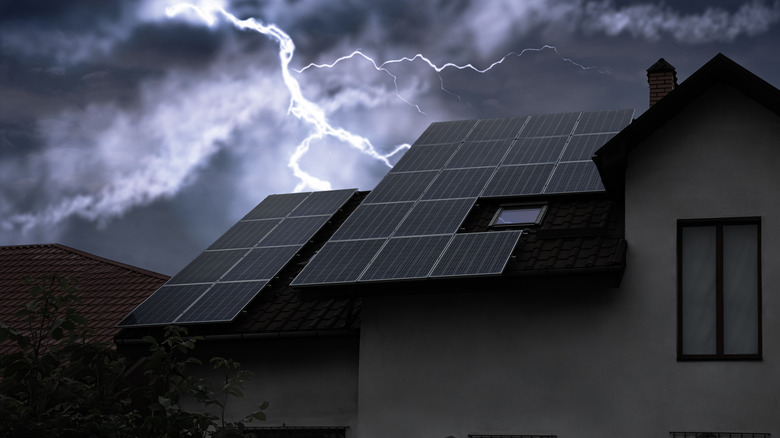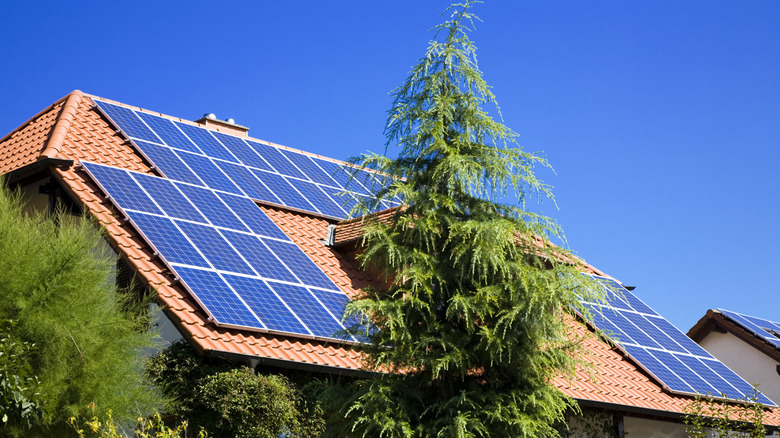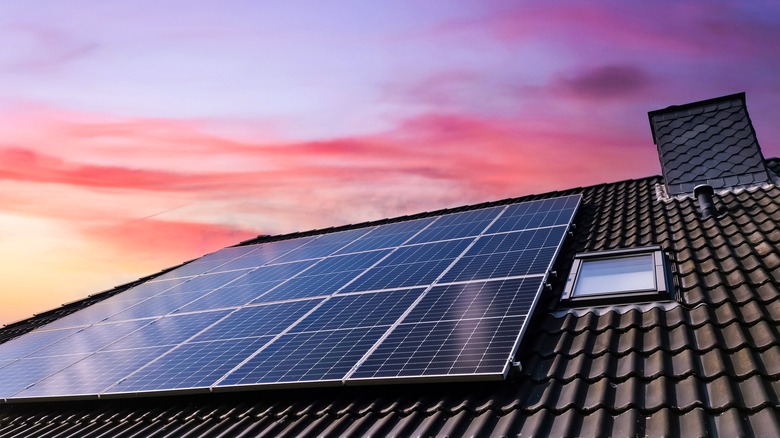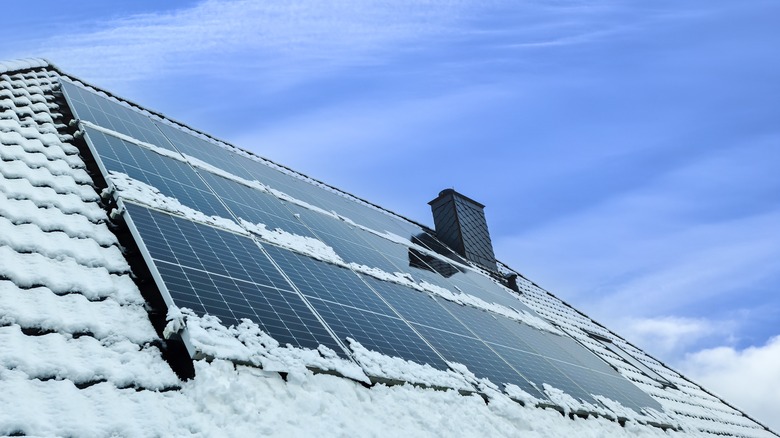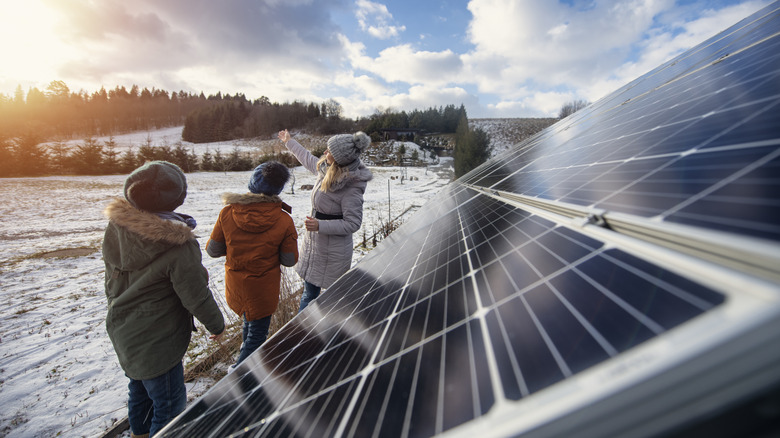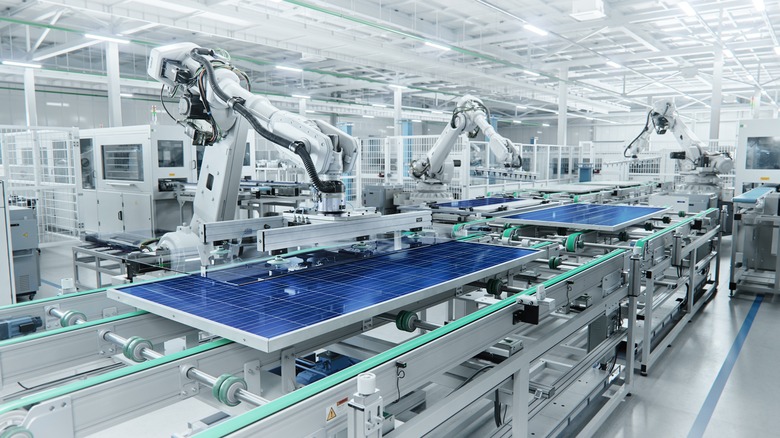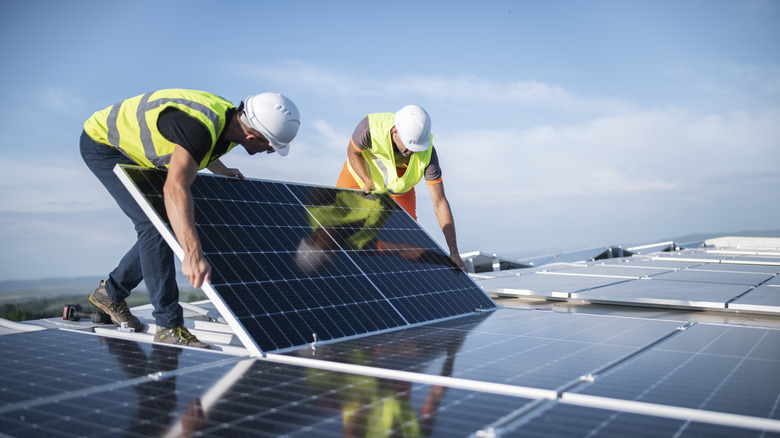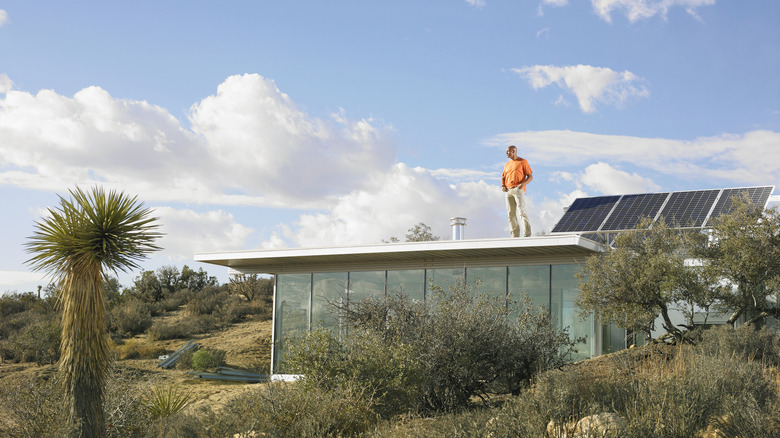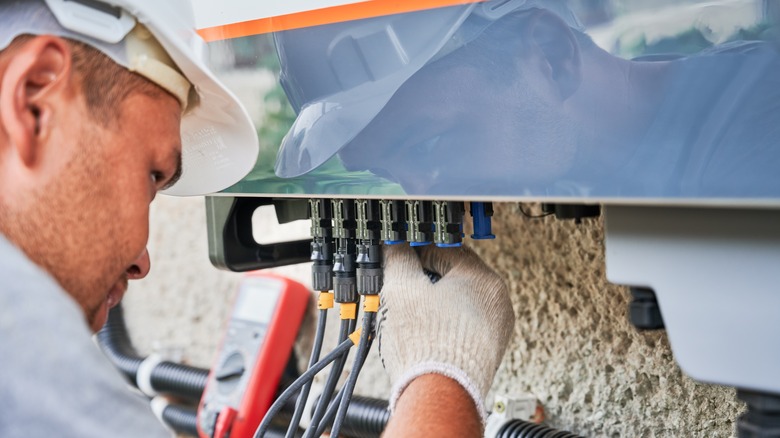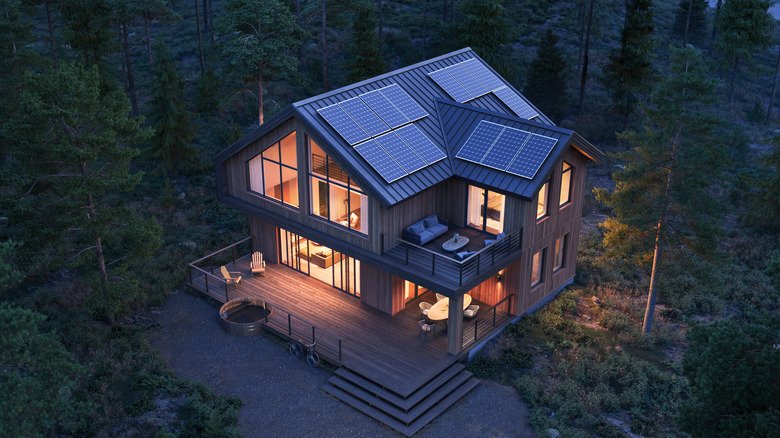10 Common Ways Solar Panels Break (And How To Protect Them)
Solar panels can save money, energy, and frustration, but they're not a perfect solution to home energy needs. Though solar panels can increase home values, there are also downsides to consider. Photovoltaic (PV) modules require regular maintenance, so while solar is passive, you don't get to be. Even with careful upkeep, failures happen and solar panels break. And for as much as they can reduce your power bill, they still come with a large cost up-front (remember, solar panels can take up to a decade to pay themselves off).
If you've decided that solar panels are worth the investment, it makes sense to learn what you can do to protect them. Let's take a deep dive into common ways solar panels fail so you'll be prepared if it happens. From micro-scratches that slowly decrease efficiency to large-scale accidents that immediately cut off power generation, so much can go wrong and with little warning. Here are the common ways solar panels break — and tips on how to protect them.
Large hail
Hail may not be the most common weather event everywhere in the world, but it's one of the biggest risks to your solar panel setup. Hail can have the same impact as a small rock, and tons of it falling over your solar panels can, of course, cause cracks and even holes.
It doesn't take fist-sized balls of ice to damage solar panels, either. Hail measuring 1.75 inches or more in diameter causes massive damage to photovoltaic (PV) modules. Unsurprisingly, it's easier to preemptively prepare for hail storms versus mitigating the damage afterward.
Before potentially shelling out $10-$20 per square foot for solar panels, read the fine print for durability and weather resistance information on your equipment. One of the best ways to protect your panels from being destroyed by hail is to choose a panel with a high impact protection rating.
Other protective measures include coating your panels with Methacrylate, making physical hail barriers from mesh, or putting up a temporary canopy during major storms.
Falling trees
A tree falling on your home can be catastrophic and the same goes for solar panels. What's worse is that while homeowner's insurance generally covers natural disasters, solar panels may not have the same protection. Solar panels often qualify for coverage, but if you install them after buying a home, it's worth re-reading your policy.
Checking with your provider to add insurance coverage is a good start, but protecting your panels from falling trees also takes some prevention. Trimming or removing trees regularly helps avoid major damage to your home and solar panels. Not to mention, fire risk lowers when there is a fire break surrounding your home.
While the exact "safe" distance varies depending on the type of tree (and how secure its root system is), avoiding branches hanging over your home and removing trees that touch it are important preventative measures.
Trimming branches also reduces the amount of smaller debris — and messy sap — that will wind up scattered across your roof and solar panels. While any chainsaw will do in a pinch, consider getting high-rated tree-trimming power tools for better results and added safety.
Small debris
Scratches are one thing, but micro-scratches are a different danger. Micro-scratches are hard to see, but various types of debris create them, adding to the damage over time. Even the smallest debris can create scratches, and the resulting cracks cause power loss in solar panels, shortening their lifespan, increasing your costs, and decreasing efficiency.
Prevention involves keeping your panels clear of debris. After removing large debris like branches, one tried-and-true technique is to use a leaf blower to remove smaller items. Wiping or sweeping solar panels can cause the layer of debris to create scratches, but leaving it alone only blocks the sun and decreases your panels' efficiency. A leaf blower can be gentle enough (starting with less power) to clear off your roof without harming your panels.
Some systems may ward off scratches better than others, but this extra dose of caution can save you time and money. Whether you choose to buy an off-grid solar panel kit or lease a full set of panels from a solar company, it's worth investing some time in cleanup — in every season — to help them perform their best.
Heavy snow
The biggest threat to energy production may be a lack of light, whether it's nighttime or mid-solar eclipse. However, it's a myth that solar panels don't work in cloudy conditions. Snow can impact how much energy your solar panels collect, though a light dusting won't mean a sudden drop in energy production, according to the U.S. Department of Energy.
Research suggests that even harsh snowy conditions don't impede solar panel productivity, and a small amount of lightweight snow can easily blow away in the wind. Yet heavy snow could cause physical damage that renders them inefficient or useless. Heavy snow accumulation can block panels and cause microcracks or worse.
The Department of Energy notes that most solar panels have frames, which helps with protection but also means they are vulnerable at the mounting points. Lacking a frame can also be a good thing, as it allows snow to slide off the panels.
Letting the snow melt and slide off is ideal, but if that's not a possibility in prolonged storms, regularly clear snow off the panels for the best results. If you haven't yet purchased PV panels and live in a snowy region, choose an option with built-in wipers for mid-snowstorm convenience.
Extremely hot or cold weather
While solar panels are engineered to handle extreme conditions, cracks do happen. Solar panels can crack in either too-hot or too-cold temperatures, so it's crucial to check your panels' ratings and keep an eye on the thermostat.
The good news is that there are some simple ways to protect your panels from extreme temperatures. Some solar panels are self-cooling, using technology that mimics the way humans sweat. By cooling themselves, the solar panels can increase output while reducing the likelihood of cracks or other heat-related failures.
The opposite problem happens in areas with harsh winters, though temperature drops alone are rarely significant enough to cause cracks. Instead, what becomes risky is when homeowners use water to remove snow. This not only adds more weight to the panels but could also cause cracks due to the sudden temperature shift.
In summer, hosing down your solar panels is a good thing; many owners report seeing noticeable changes in energy production after cooling off their panels on hot days. The improvement could also be due to cleaner panels receiving more solar energy.
If you haven't bought your panels yet, choosing a sturdier one could mean less chance of damage in high temperatures. For example, monocrystalline solar panels have better heat tolerance than polycrystalline panels, which also need more space and sunlight.
Poor quality materials
If you already own solar panels, this advice is too little too late, but selecting panels made with good-quality materials can avoid many causes of solar panel breakage. A common condition called potential-induced degradation (PID) is essentially a matter of current leakage, and it happens most often in low-quality panels (though all panels are susceptible to some extent).
The average person typically can't tell whether a solar panel is good quality by sight alone or by reading the user manual, but there are a few things to look out for. For example, a study of potential-induced degradation published in Energy & Environmental Science suggests that low-quality manufacturing may not include transformers, which have a direct connection between the solar grid and the inverter. Thus, choosing an inverter with a transformer is an easy preventative measure.
Another sign of low quality is too-sensitive cells, which indicate a less effective chemical composition. Unsurprisingly, better-quality materials — such as ionomer encapsulants — help prevent PID and discoloration. Careful shopping and reading the included literature can help you avoid poor-quality solar panels that degrade faster than their competitors.
Corrosion
Because solar panels are meant to work outdoors, you might expect them to last a long time in harsh conditions. Yet something as simple as rain can cause corrosion in your panels, even if they're good quality. While physical damage to the exterior of your panels is what really lets moisture in, some corrosion is inevitable.
Solar panels typically corrode over a long period, and hot and wet conditions can worsen it. A study published in Solar Energy Materials And Solar Cells explored how heat impacted corrosion and determined that in low temperatures, the tested panels only lost about 9% of their power after 600 hours of corrosion. In high-temperature experiments, the modules lost 50% of their power at only 300 hours.
Since you can't predict the weather long-term, it's tough to know how quickly your panels might corrode. The power loss may not be as predictable, either, but it's still possible. Thus, it's important to clean and inspect your panels regularly to catch corrosion before it does damage. You can also reseal or add protective coatings to damaged panels to help prolong their life even after corrosion begins.
Delamination
Delamination is a common way solar panels break down, and it's also unavoidable in the long run. However, there are some ways to protect your panels and ensure they keep producing power for longer.
Delamination can result from poor manufacturing processes, so this is another case where research is prudent. It also happens as solar panels age and experience weather conditions. Moisture is often the culprit, though dropping or otherwise mishandling the panels can also cause delamination.
The type of solar panel you choose matters, too: Thin film solar panels are versatile but can be more susceptible to delamination because of their flexibility. On the plus side, it might be easier to see damage on a thin film panel and get it repaired; the thin front glass means scratches will be more prominent.
Avoiding delamination entirely isn't possible, but checking your panels for damage can help prevent it for as long as possible. A professional (or a professional-grade product) can fill gaps, repair scratches, and help your panels perform better and last longer.
Inverter malfunctions
Depending on where you purchase your PV panels and how many you need, you'll likely have an installation crew handling the nitty gritty. But whether you're a DIYer or hire a company, it helps to understand your panels' wattage and inverter needs. The correct inverter can help your panels perform their best, while the wrong one can cause failures.
Solar panels should match their inverter capacity; a disconnect can cause panels to perform less efficiently or sustain electrical damage. The best-case scenario is to have an inverter that matches or slightly exceeds your solar panels' output. That way, you avoid solar clipping, which is when your panels provide more energy than the inverter can take on. In that case, you'll miss out on energy as it's lost in the conversion.
There is one caveat buried in solar clipping: As your system's output decreases over time, it may eventually match the inverter's capacity. That might mean you pay less upfront for a smaller inverter and lose less energy over time rather than paying more upfront and getting more energy back.
Even if you select the right inverter to match the power output of the solar array, there's no guarantee that it will last for the lifetime of your solar panels. One survey suggests an inverter failure rate of 34.3%, noting that inverters should last around 15 years.
Time
Unfortunately, time could be the biggest hazard for your solar panels, even with proper maintenance and removing debris. Nothing lasts forever, and despite improvements, that applies to solar panels, too.
The U.S. Department of Energy website says the estimated lifespan of a photovoltaic model is 30 to 35 years. Over time, solar systems lose power and efficiency, so some owners might want to replace their panels before the 30-year mark, even if they haven't fully broken.
For prospective solar owners, it can seem daunting to make such a large purchase knowing it won't last forever, but there's also good news. Many of the risks to solar panels are avoidable if you choose the right products for your property and climate and maintain the system regularly.
Consumers can choose from different types of solar panels, so research and possibly paying more up-front is essential for reliable, long-term solar energy generation. Building protection into your panel array — whether by adding physical barriers or removing nearby trees — is also a helpful preventative measure to extend the life of your PV system.
